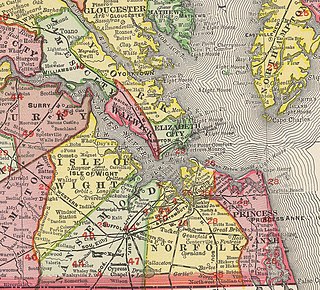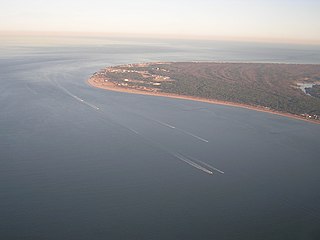
The Jamestown settlement in the Colony of Virginia was the first permanent English settlement in the Americas. It was located on the northeast bank of the James (Powhatan) River about 2.5 mi (4 km) southwest of the center of modern Williamsburg. It was established by the Virginia Company of London as "James Fort" on May 4, 1607 O.S., and was considered permanent after a brief abandonment in 1610. It followed several failed attempts, including the Lost Colony of Roanoke, established in 1585 on Roanoke Island, later part of North Carolina. Jamestown served as the colonial capital from 1616 until 1699. Despite the dispatch of more settlers and supplies, including the 1608 arrival of eight Polish and German colonists and the first two European women, more than 80 percent of the colonists died in 1609–10, mostly from starvation and disease. In mid-1610, the survivors abandoned Jamestown, though they returned after meeting a resupply convoy in the James River.

Jamestown Settlement is a living history museum operated by the Commonwealth of Virginia, created in 1957 as Jamestown Festival Park for the 350th anniversary celebration. Today it includes a recreation of the original James Fort, a Powhatan Native American town, indoor and outdoor displays, and replicas of the original settlers' ships: the Susan Constant, Godspeed, and Discovery.

James City County is a county located in the Commonwealth of Virginia. As of the 2020 census, the population was 78,254. Although politically separate from the county, the county seat is the adjacent independent city of Williamsburg.

The Colony of Virginia, chartered in 1606 and settled in 1607, was the first enduring English colony in North America, following failed attempts at settlement on Newfoundland by Sir Humphrey Gilbert in 1583 and the colony of Roanoke by Sir Walter Raleigh in the late 1580s.

The London Company, officially known as the Virginia Company of London, was a division of the Virginia Company with responsibility for colonizing the east coast of North America between latitudes 34° and 41° N.

The Virginia Company was an English trading company chartered by King James I on 10 April 1606 with the object of colonizing the eastern coast of America. The coast was named Virginia, after Elizabeth I, and it stretched from present-day Maine to the Carolinas. The company's shareholders were Londoners, and it was distinguished from the Plymouth Company, which was chartered at the same time and composed largely of gentlemen from Plymouth, England.
Sir Samuel Argall was an English adventurer and naval officer.
The Jamestown supply missions were a series of fleets from 1607 to around 1611 that were dispatched from England by the London Company with the specific goal of initially establishing the Company's presence and later specifically maintaining the English settlement of "James Fort" on present-day Jamestown Island. The supply missions also resulted in the colonization of Bermuda as a supply and way-point between the colony and England.

Discovery or Discoverie was a small 20-ton, 38-foot (12 m) long "fly-boat" of the British East India Company, launched before 1602. It was one of the three ships on the 1606–1607 voyage to the New World for the English Virginia Company of London. The journey resulted in the founding of Jamestown in the new Colony of Virginia.

County of Princess Anne is a former county in the British Colony of Virginia and the Commonwealth of Virginia in the United States, first incorporated in 1691. The county was merged into the city of Virginia Beach on January 1, 1963, ceasing to exist.

Cape Henry is a cape on the Atlantic shore of Virginia located in the northeast corner of Virginia Beach. It is the southern boundary of the entrance to the long estuary of the Chesapeake Bay.

Sir Thomas Gates (fl.?–1622), was the governor of Jamestown, in the English colony of Virginia. His predecessor, George Percy, through inept leadership, was responsible for the lives lost during the period called the Starving Time. The English-born Gates arrived to find a few surviving starving colonists commanded by Percy, and assumed command. Gates ruled with deputy governor Sir Thomas Dale. Their controlled, strict methods helped the early colonies survive. Sir Thomas was knighted in 1596 by Robert Devereux, 2nd Earl of Essex for gallantry at the Capture of Cadiz. His knighthood was later royally confirmed by Queen Elizabeth I.
Martin's Hundred was an early 17th-century plantation located along about ten miles (16 km) of the north shore of the James River in the Virginia Colony east of Jamestown in the southeastern portion of present-day James City County, Virginia. The Martin's Hundred site is described in detail in the eponymous book of Ivor Noel Hume first published in 1979.

Historic Jamestown is the cultural heritage site that was the location of the 1607 James Fort and the later 17th-century town of Jamestown in America. It is located on Jamestown Island, on the James River at Jamestown, Virginia and operated as a partnership between Preservation Virginia and the U.S. National Park Service as part of Colonial National Historical Park.

The Lynnhaven River is a tidal estuary located in the independent city of Virginia Beach, Virginia, in the United States, and flows into the Chesapeake Bay west of Cape Henry at Lynnhaven Inlet, beyond which is Lynnhaven Roads. It has a small, developed watershed covering 64 square miles (170 km2), terminating at Lynnhaven Bay. It was once famous along the East Coast of the United States for its oysters, which declined through pollution and runoff. It is now being restored by the Lynnhaven River Now restoration project based out of the Brock Environmental Center. A proposed comprehensive project for ecosystem restoration of the Lynnhaven River Basin is currently under consideration by the United States Congress.
The Starving Time at Jamestown in the Colony of Virginia was a period of starvation during the winter of 1609–1610. There were about 500 Jamestown residents at the beginning of the winter. However, there were only 61 people still alive when the spring arrived.

The history of Virginia Beach, Virginia, goes back to the Native Americans who lived in the area for thousands of years before the English colonists landed at Cape Henry in April 1607 and established their first permanent settlement at Jamestown a few weeks later. The Colonial Virginia period extended until 1776 and the American Revolution, and the area has been part of the Commonwealth of Virginia ever since.

Jamestown Rediscovery is an archaeological project of Preservation Virginia investigating the remains of the original English settlement at Jamestown established in the Virginia Colony in North America beginning on May 14, 1607.

Jamestown, also Jamestowne, was the first settlement of the Virginia Colony, founded in 1607, and served as the capital of Virginia until 1699, when the seat of government was moved to Williamsburg. This article covers the history of the fort and town at Jamestown proper, as well as colony-wide trends resulting from and affecting the town during the time period in which it was the colonial capital of Virginia.
William Powell, was an early Virginia colonist, landowner, militia officer, Ancient Planter and member of the first Virginia House of Burgesses in 1619. He was one of the two representatives of James City County, Virginia.















